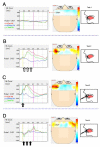Effects of Tongue Pressure on Cerebral Blood Volume Dynamics: A Functional Near-Infrared Spectroscopy Study
- PMID: 35204059
- PMCID: PMC8870264
- DOI: 10.3390/brainsci12020296
Effects of Tongue Pressure on Cerebral Blood Volume Dynamics: A Functional Near-Infrared Spectroscopy Study
Abstract
Tongue pressure measurement (TPM) is an indicator of oral function. However, the association between tongue pressure and cerebral activation remains unclear. We used near-infrared spectroscopy (NIRS) to examine the correlation between cerebral cortex activation and tongue pressure stimulation against the anterior palatal mucosa. We measured voluntary maximum tongue pressure (MTP) using a TPM device; a pressure value of approximately 60% of the MTP was used for the experimental tongue pressure (MTP60%). We examined the effect of oral functional tongue pressure stimulation against the anterior palatal mucosa on cerebral activation using NIRS in 13 adults. Tongue pressure stimulation caused significant changes in cerebral blood flow in some areas compared with controls (p < 0.05). We performed a correlation analysis (p < 0.05) between MTP60% and changes in oxygenated hemoglobin in all 47 NIRS channels. MTP60% triggered activation of the right somatosensory motor area and right dorsolateral prefrontal cortex and deactivation of the anterior prefrontal cortex (APFC). TPM balloon-probe insertion in the oral cavity activated the bilateral somatosensory motor area and deactivated the wide area of the APFC. Moreover, MTP60% via the TPM balloon probe activated the bilateral somatosensory and motor cortex areas. Tongue pressure stimulation changes cerebral blood flow, and NIRS is useful in investigating the relationship between oral stimulation and brain function.
Keywords: cerebral blood volume; cerebral cortex hemodynamics; near-infrared spectroscopy; tongue pressure measurement.
Conflict of interest statement
The authors declare no conflict of interest.
Figures





Similar articles
-
Language-activated cerebral blood oxygenation and hemodynamic changes of the left prefrontal cortex in poststroke aphasic patients: a near-infrared spectroscopy study.Stroke. 1998 Jul;29(7):1299-304. doi: 10.1161/01.str.29.7.1299. Stroke. 1998. PMID: 9660376
-
Cerebral haemodynamic response to somatosensory stimulation in near-term fetal sheep.J Physiol. 2017 Feb 15;595(4):1289-1303. doi: 10.1113/JP273163. Epub 2016 Dec 11. J Physiol. 2017. PMID: 27805787 Free PMC article.
-
Cerebral Oxygenation Dynamics of the Prefrontal Cortex and Motor-Related Area During Cardiopulmonary Exercise Test: A Near-Infrared Spectroscopy Study.Adv Exp Med Biol. 2020;1232:231-237. doi: 10.1007/978-3-030-34461-0_29. Adv Exp Med Biol. 2020. PMID: 31893415
-
Evaluation of pressure-induced pain in patients with disorders of consciousness based on functional near infrared spectroscopy.Front Neurol. 2025 Apr 7;16:1542691. doi: 10.3389/fneur.2025.1542691. eCollection 2025. Front Neurol. 2025. PMID: 40260139 Free PMC article.
-
[Detection of changes in cerebral blood flow and cerebrovascular autoregulation by near-infrared spectroscopy in newborn piglets].Zhonghua Er Ke Za Zhi. 2007 May;45(5):349-53. Zhonghua Er Ke Za Zhi. 2007. PMID: 17697620 Chinese.
Cited by
-
Changes in temporal lobe activation during a sound stimulation task in patients with sensorineural tinnitus: a multi-channel near-infrared spectroscopy study.Biomed Eng Online. 2024 Jun 21;23(1):59. doi: 10.1186/s12938-024-01255-7. Biomed Eng Online. 2024. PMID: 38902700 Free PMC article.
-
Current evidence on the association of tongue strength with cognitive decline in older adults and the known risk factors of frailty, sarcopenia and nutritional health: a scoping review protocol.BMJ Open. 2023 Oct 28;13(10):e076005. doi: 10.1136/bmjopen-2023-076005. BMJ Open. 2023. PMID: 37898485 Free PMC article.
References
-
- Nakamori M., Hosomi N., Ishikawa K., Imamura E., Shishido T., Ohshita T., Yoshikawa M., Tsuga K., Wakabayashi S., Maruyama H., et al. Prediction of pneumonia in acute stroke patients using tongue pressure measurements. PLoS ONE. 2016;11:e0165837. doi: 10.1371/journal.pone.0165837. - DOI - PMC - PubMed
-
- Momose T., Nishikawa J., Watanabe T., Sasaki Y., Senda M., Kubota K., Sato Y., Funakoshi M., Minakuchi S. Effect of mastication on regional cerebral blood flow in humans examined by positron-emission tomography with 15O-labelled water and magnetic resonance imaging. Arch. Oral Biol. 1997;42:57–61. doi: 10.1016/S0003-9969(96)00081-7. - DOI - PubMed
Grants and funding
LinkOut - more resources
Full Text Sources

